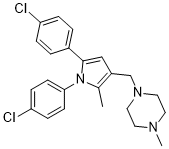BM-212 is a potent antimycobacterial agent and MmpL3 inhibitor. BM-212 was shown to possess strong inhibitory activity against both Mycobacterium tuberculosis and some nontuberculosis mycobacteria. BM212 was inhibitory to drug-resistant mycobacteria and also exerted bactericidal activity against intracellular bacilli residing in the U937 human histiocytic lymphoma cell line.
Physicochemical Properties
| Molecular Formula | C23H25CL2N3 |
| Molecular Weight | 414.374 |
| Exact Mass | 413.142 |
| Elemental Analysis | C, 66.67; H, 6.08; Cl, 17.11; N, 10.14 |
| CAS # | 146204-42-4 |
| Related CAS # | 146204-42-4; |
| PubChem CID | 456926 |
| Appearance | Solid powder |
| Density | 1.2±0.1 g/cm3 |
| Boiling Point | 528.3±50.0 °C at 760 mmHg |
| Flash Point | 273.3±30.1 °C |
| Vapour Pressure | 0.0±1.4 mmHg at 25°C |
| Index of Refraction | 1.622 |
| LogP | 5.32 |
| Hydrogen Bond Donor Count | 0 |
| Hydrogen Bond Acceptor Count | 2 |
| Rotatable Bond Count | 4 |
| Heavy Atom Count | 28 |
| Complexity | 480 |
| Defined Atom Stereocenter Count | 0 |
| SMILES | CN1CCN(CC2=C(C)N(C3=CC=C(Cl)C=C3)C(C4=CC=C(Cl)C=C4)=C2)CC1 |
| InChi Key | YWZIODCWLMCMMW-UHFFFAOYSA-N |
| InChi Code | InChI=1S/C23H25Cl2N3/c1-17-19(16-27-13-11-26(2)12-14-27)15-23(18-3-5-20(24)6-4-18)28(17)22-9-7-21(25)8-10-22/h3-10,15H,11-14,16H2,1-2H3 |
| Chemical Name | 1-((1,5-bis(4-chlorophenyl)-2-methyl-1H-pyrrol-3-yl)methyl)-4-methylpiperazine |
| Synonyms | BM-212; BM 212; BM212. |
| HS Tariff Code | 2934.99.9001 |
| Storage |
Powder-20°C 3 years 4°C 2 years In solvent -80°C 6 months -20°C 1 month |
| Shipping Condition | Room temperature (This product is stable at ambient temperature for a few days during ordinary shipping and time spent in Customs) |
Biological Activity
| Targets | M. tuberculosis |
| ln Vitro |
At 2 μg/mL and 8 μg/mL, BM212 completely destroys the hydrophobic nanodomains seen on S cells but has no discernible effect on R cells, causing significant structural changes in the M. abscessus CIP104536T S and R variants[3]. Mycobacterium avium's activity in U937 cells is inhibited by BM212 (0.5–10 μg/mL, 7 days) in a dose-dependent manner, with a MIC of 0.5 μg/mL and 100% inhibition beginning at a concentration of 1 μg/mL[4]. |
| References |
[1]. Bactericidal activities of the pyrrole derivative BM212 against multidrug-resistant and intramacrophagic Mycobacterium tuberculosis strains. Antimicrob Agents Chemother. 1998 Nov;42(11):3035-7. [2].Improved BM212 MmpL3 inhibitor analogue shows efficacy in acute murine model of tuberculosis infection. PLoS One. 2013;8(2) [3]. Fast chemical force microscopy demonstrates that glycopeptidolipids define nanodomains of varying hydrophobicity on mycobacteria. Nanoscale Horiz. 2020 Jun 1;5(6):944-953. [4]. Bactericidal activities of the pyrrole derivative BM212 against multidrug-resistant and intramacrophagic Mycobacterium tuberculosis strains. Antimicrob Agents Chemother. 1998 Nov;42(11):3035-7. |
Solubility Data
| Solubility (In Vitro) |
Ethanol : ~5.56 mg/mL (~13.42 mM ) DMSO : ~1 mg/mL (~2.41 mM) |
| Solubility (In Vivo) |
Solubility in Formulation 1: ≥ 0.56 mg/mL (1.35 mM) (saturation unknown) in 10% EtOH + 40% PEG300 + 5% Tween80 + 45% Saline (add these co-solvents sequentially from left to right, and one by one), clear solution. For example, if 1 mL of working solution is to be prepared, you can add 100 μL of 5.6 mg/mL clear EtOH stock solution to 400 μL PEG300 and mix evenly; then add 50 μL Tween-80 to the above solution and mix evenly; then add 450 μL normal saline to adjust the volume to 1 mL. Preparation of saline: Dissolve 0.9 g of sodium chloride in 100 mL ddH₂ O to obtain a clear solution. Solubility in Formulation 2: ≥ 0.56 mg/mL (1.35 mM) (saturation unknown) in 10% EtOH + 90% (20% SBE-β-CD in Saline) (add these co-solvents sequentially from left to right, and one by one), clear solution. For example, if 1 mL of working solution is to be prepared, you can add 100 μL of 5.6 mg/mL clear EtOH stock solution to 900 μL of 20% SBE-β-CD physiological saline solution and mix evenly. Preparation of 20% SBE-β-CD in Saline (4°C,1 week): Dissolve 2 g SBE-β-CD in 10 mL saline to obtain a clear solution. Solubility in Formulation 3: ≥ 0.56 mg/mL (1.35 mM) (saturation unknown) in 10% EtOH + 90% Corn Oil (add these co-solvents sequentially from left to right, and one by one), clear solution. For example, if 1 mL of working solution is to be prepared, you can add 100 μL of 5.6 mg/mL clear EtOH stock solution to 900 μL of corn oil and mix well. Solubility in Formulation 4: 10% EtOH+40% PEG300+5% Tween-80+45% Saline: ≥ 0.56 mg/mL (1.35 mM) (Please use freshly prepared in vivo formulations for optimal results.) |
| Preparing Stock Solutions | 1 mg | 5 mg | 10 mg | |
| 1 mM | 2.4133 mL | 12.0665 mL | 24.1330 mL | |
| 5 mM | 0.4827 mL | 2.4133 mL | 4.8266 mL | |
| 10 mM | 0.2413 mL | 1.2067 mL | 2.4133 mL |
